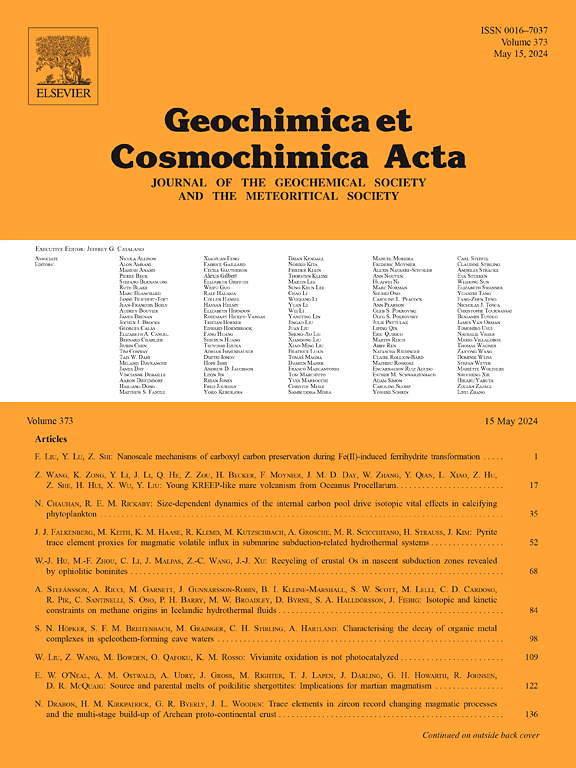影响brgmgt衍生温度代用指标的主要环境变量在湖泊表层沉积物和沉积物岩心中存在差异
IF 5
1区 地球科学
Q1 GEOCHEMISTRY & GEOPHYSICS
引用次数: 0
摘要
支化甘油单烷基甘油四醚(brGMGTs)是一组结构类似于支化甘油二烷基甘油四醚(brGDGTs)的孤儿膜脂,已被提出作为定量湖泊古温度重建的有前途的工具。然而,基于brGMGT的温度代用指标的适用性以及盐度和溶解氧(DO)浓度对brGMGT分布的影响在很大程度上仍未得到探索,这限制了它们作为可靠和定量的古气候代用指标在沉积物岩心中的应用。为了解决这些不确定性,我们研究了中国西部不同温度和盐度湖泊表层沉积物中的brGMGT浓度和分布,以及阳宗海湖泊中具有宽DO浓度梯度的样带。研究结果表明,湖泊表层沉积物中brGMGTs含量丰富,且主要是原生的,周围土壤的贡献很小。温度是影响brGMGT分布的主要因素。基于brgmgt的brGMGTII与中国西部和东非湖泊表层沉积物年平均气温(MAAT)呈显著相关(R2 = ,分别为0.90和0.91);p均为 <; 0.01),表明其作为古温标的潜力。在这些地区建立了BrGMGTII温度重建校准,RMSE(均方根误差)值分别为2.8 °C和2.6 °C。此外,高盐度似乎会降低brGMGTs的甲基化程度,而低DO浓度可能会增加brGMGTs相对于brGDGTs的相对丰度,尽管DO对brGMGTI和brGMGTII的影响较为复杂。进一步分析阳宗海全新世沉积物岩心中的brGMGTs,发现这些brGMGTs衍生的温度代用物推断出了不切实际的温度趋势和绝对值。这可能是由于(1)非温度因素,特别是DO浓度,可能比温度本身对沉积物岩心中brGMGT分布的影响更大;(2) brGMGT对温度响应的独特机制,即细菌群落在高温和低温brGMGT生产者之间的转变,而不是膜脂的均匀粘性适应。本文章由计算机程序翻译,如有差异,请以英文原文为准。
Dominant environmental variables affecting brGMGT-derived temperature proxies differ in lake surface sediments and sediment cores
Branched glycerol monoalkyl glycerol tetraethers (brGMGTs), a suite of orphan membrane lipids structurally similar to branched glycerol dialkyl glycerol tetraethers (brGDGTs), have been proposed as promising tools for quantitative paleotemperature reconstruction in lakes. However, the applicability of brGMGT-based temperature proxies and the influence of salinity and dissolved oxygen (DO) concentration on brGMGT distributions remain largely unexplored, limiting their use as reliable and quantitative paleoclimate proxies in sediment cores. To address these uncertainties, we examined brGMGT concentrations and distributions in surface sediments from West China lakes with varying temperatures and salinities, as well as transects in Lake Yangzonghai featured by a wide gradient of DO concentration. Our results show that brGMGTs are abundant and primarily autochthonous in lake surface sediments, with minimal contributions from surrounding soils. Temperature was found to be the primary factor influencing brGMGT distributions. The brGMGT-based proxy brGMGTII, newly proposed in this study, shows significant correlations with mean annual air temperature (MAAT) in surface sediments from both West China and East African lakes (R2 = 0.90 and 0.91, respectively; both p < 0.01), underscoring its potential as paleotemperature indicator. BrGMGTII calibrations for temperature reconstructions were established for these regions, yielding RMSE (Root mean squared error) values of 2.8 °C and 2.6 °C, respectively. Additionally, high salinity appears to reduce the methylation degree of brGMGTs, whereas low DO concentration may increase the relative abundance of brGMGTs vs. brGDGTs, though DO shows a complex effect on brGMGTI and brGMGTII. Further analysis of brGMGTs in a Holocene sediment core from Lake Yangzonghai in China reveals that these brGMGT-derived temperature proxies inferred unrealistic temperature trends and absolute values. This is likely due to (1) non-temperature factors, particularly DO concentration, which may exert a stronger influence on brGMGT distributions in sediment core than temperature itself; and (2) the unique mechanism by which brGMGTs respond to temperature, i.e., shifts in bacterial communities between high- and low-temperature brGMGT producers rather than a homeoviscous adaptation of membrane lipids.
求助全文
通过发布文献求助,成功后即可免费获取论文全文。
去求助
来源期刊

Geochimica et Cosmochimica Acta
地学-地球化学与地球物理
CiteScore
9.60
自引率
14.00%
发文量
437
审稿时长
6 months
期刊介绍:
Geochimica et Cosmochimica Acta publishes research papers in a wide range of subjects in terrestrial geochemistry, meteoritics, and planetary geochemistry. The scope of the journal includes:
1). Physical chemistry of gases, aqueous solutions, glasses, and crystalline solids
2). Igneous and metamorphic petrology
3). Chemical processes in the atmosphere, hydrosphere, biosphere, and lithosphere of the Earth
4). Organic geochemistry
5). Isotope geochemistry
6). Meteoritics and meteorite impacts
7). Lunar science; and
8). Planetary geochemistry.
 求助内容:
求助内容: 应助结果提醒方式:
应助结果提醒方式:


